
- Private Sailing Courses
- Fast Track to Monohull Cruising
- Learn to Sail Certification Courses
- Fast Track to Sailing
- Family Learn to Sail Programs
- Sailing Lessons and Sailing Rides
- Small Sailboat Cruising Course
- Online Learn to Sail Course
- Docking Refresher Course on a Catamaran or Monohull
- Live Aboard Cruising Courses
- Bareboat Charter Courses
- Catamaran Cruising Courses
- IPC Prep With Cruising Certification & Catamaran Endorsement
- Catamaran Endorsement & Refresher
- Boat Handling & Docking
- Women-Only Sailing Programs
- Navigation Courses
- Performance Sailing Courses
- Fast Track to Sailboat Racing Courses
- Performance Racing Clinics
- Coastal Passage Making Courses
- Offshore Passage Making Courses
- Celestial Navigation Courses
- Powerboat Courses
- Sailing Certifications
- Top 10 Tips for Learning How to Sail
- Safety and Comfort Aboard
- Sails & Sail Trim
- Steering and Maneuvering
- Handling Spinnakers
- Engine Maintenance
- Become an Instructor
- How to Choose a Sailing School
- Yacht Lease Management

DOCKING UNDER POWER
In this sailboat docking video, Offshore Sailing School Founder, Steve Colgate, shows you the best way to dock under power. This simple system gives you excellent control whether you are sailing with others or single-handed. Here are some helpful hints on how to dock a sailboat:
- Set up your aft amidships spring line first
- Power into the dock very slowly
- Drop the spring line over a piling or cleat
- Power against the spring line to stay tight to the dock while you put all the other lines ashore
HOW TO SPRING OFF OF A DOCK
In this video, you learn how to use spring lines on a sailboat to get out of a tight spot when the wind is pushing your boat onto the dock. Here are some helpful hints:
- Double up on the bow line and double back on the forward spring line by running each of these lines from a bow cleat and stern cleat, around a piling on the dock, and back to the cleat again
- Put the engine in reverse and bow will pivot out
- Make sure you have someone with a roving fender at the stern to protect against hitting the dock
- As you drive forward, clear the aft-leading spring line, then the stern line, and next the bow line by releasing the top part of the line on the cleats as you drive straight forward
- Be prepared to release both ends, in case one end gets caught on the dock
GET IN TOUCH
Call us today.
888-454-7015 or 239-454-1700
Ask our experts about training, group packages, vacations, and more!

6338 Presidential Court, #201 Fort Myers, Florida 33919
SPECIALS COURSES
Site Map Privacy Policy
LOCATIONS CONTACT US
ABOUT US SAILING TIPS
OPPORTUNITIES
© 2024 Offshore Sailing School - Official Site. OffshoreSailing.com is managed by Offshore Sailing School.
- Privacy Policy
- Fast Track to Sailing | Beginner to Advanced in Six Days
- Fast Track to Catamaran Cruising
- Fast Track to Boat Handling & Docking
- Ultimate Cruising Course
- Private Courses
- Catamaran Refresher & 114 Endorsement
- Team Building Programs
- Women’s Sail Sip Spa Week in the British Virgin Islands
- Top 10 Tips Learning How to Sail
- How to Become a Sailing Instructor
- Yacht Lease Management Opportunities
- Bookstore New!
- About Sailing
- Captiva Island
- St. Petersburg
- Fort Myers Beach
- Scrub Island
- St. Lucia & Windward Islands
- Greece Ionian Islands
- Sicily In The Aeolian Islands
- Dubrovnik-Montenegro Flotilla Cruise
- Italy’s Amalfi Coast Flotilla
- Tahiti’s Society Islands
- Team Building
- Testimonials
- News, Specials & Events
- Offshore Sailing School Returns to Captiva Island, Florida
- Sailing – Out & About SWFL
- America’s Cup Endeavor Program Videos
- Growing Up Moorings
- Doris Colgate Sailing Clinic & Cup
- Steve Colgate Inducted Into National Sailing Hall of Fame
- OSS Student Proposes During Course
- Steve Colgate and National Sailing Hall of Fame
- St. Lucia and Windward Islands Flotilla Cruise
- Weathering Unexpected Bad Weather
- A Sailing Adventure He Still Can’t Believe Was Real
- 2016 Croatia Flotilla Cruise Diary
- How We Teach
- Steve & Doris Colgate
- Steve Colgate
- Doris Colgate
- Management Team
- Employment Opportunities
- Our Mission
- Our History
- Alumni Benefits
- Awards & Accolades
- Our Philanthropy
- Certification Levels
- GET STARTED
How to dock and undock your sailboat
Docking and undocking a sailboat may seem daunting, but with practice and proper technique, it can be easily mastered. Gain confidence and avoid common mistakes with our comprehensive guide.
How to Dock and Undock Your Sailboat
Docking and undocking your sailboat can be a daunting task, especially for those new to the sailing lifestyle. However, with practice and the right techniques, you’ll soon be able to confidently maneuver your boat in and out of the dock like a pro. In this comprehensive guide, we’ll cover everything you need to know about docking and undocking your sailboat, from the basics to advanced techniques.
Table of Contents
Understanding docking and undocking, preparing for docking, docking techniques, undocking techniques, docking and undocking in different conditions, common mistakes and how to avoid them, practice makes perfect.
Docking refers to the process of bringing your sailboat alongside a dock, pier, or slip, and securing it in place. Undocking, on the other hand, is the process of releasing your boat from its moorings and maneuvering it away from the dock. Both docking and undocking require a combination of boat handling skills, knowledge of wind and current conditions, and effective communication with your crew.
Before you approach the dock, it’s essential to prepare your boat and crew for the docking process. Here are some steps to follow:
1. Assess the Docking Area
Take note of the wind and current conditions, as well as any obstacles or other boats in the area. This will help you determine the best approach for docking your sailboat.
2. Prepare Dock Lines and Fenders
Ensure that your dock lines (also known as mooring lines) are ready for use. You’ll need at least two lines: one for the bow (front) and one for the stern (back) of your boat. It’s also a good idea to have a spring line, which runs diagonally from the bow or stern to the dock, to help control your boat’s movement.
Fenders are essential for protecting your boat from damage while docking. Attach them to the side of your boat that will be facing the dock, and adjust their height so they’ll be positioned between your boat and the dock.
3. Assign Roles to Your Crew
Make sure everyone on board knows their role during the docking process. This may include handling dock lines, adjusting fenders, or providing guidance as you maneuver your boat.
4. Approach the Dock Slowly and at a Controlled Speed
As you approach the dock, maintain a slow and controlled speed. This will give you more time to react to any changes in wind or current conditions and make adjustments as needed.
There are several techniques for docking your sailboat, depending on the type of dock and the conditions you’re facing. Here are some common methods:
1. Parallel Docking
This is the most common method of docking, where you bring your boat alongside the dock in a parallel position. To execute this technique:
- Approach the dock at a shallow angle, with your bow pointed slightly towards the dock.
- As you get closer, turn your boat so that it’s parallel to the dock, and use your engine or sails to maintain a slow forward motion.
- When your boat is alongside the dock, use your dock lines to secure the bow and stern to the dock cleats or pilings.
- Adjust your fenders as needed to protect your boat from the dock.
2. Mediterranean Mooring
This method involves backing your boat into a slip or berth, with the stern facing the dock. Mediterranean mooring is common in marinas with limited space or where boats are moored close together. To perform this technique:
- Approach the slip or berth at a shallow angle, with your stern facing the dock.
- Use your engine or sails to slowly reverse your boat into the slip, while keeping an eye on any obstacles or neighboring boats.
- As your boat enters the slip, have your crew secure the stern lines to the dock cleats or pilings.
- Once the stern is secured, use your bow lines to pull your boat forward and secure it in place.
3. Single-Handed Docking
If you’re sailing solo or with a limited crew, you may need to dock your boat single-handedly. This can be challenging, but with practice and the right technique, it’s possible to dock your sailboat safely on your own. Here are some tips for single-handed docking:
- Use an autopilot or self-steering system to help maintain your boat’s course and speed while you prepare your dock lines and fenders.
- Approach the dock slowly and at a shallow angle, giving yourself plenty of time to react and make adjustments.
- Secure your boat’s bow line first, as this will give you more control over your boat’s movement.
- Once the bow is secured, use your engine or sails to bring the stern alongside the dock, and secure the stern line.
Undocking your sailboat requires just as much skill and preparation as docking. Here are some steps to follow when undocking:
1. Prepare Your Boat and Crew
Before you release your boat from its moorings, ensure that your crew is ready and aware of their roles during the undocking process. This may include handling dock lines, keeping an eye on other boats or obstacles, or providing guidance as you maneuver your boat away from the dock.
2. Release Your Dock Lines
Start by releasing your stern line, followed by your bow line. If you have a spring line, release it last. Be sure to keep a hold of your dock lines as you release them, so they don’t fall into the water or get caught on your boat’s propeller.
3. Use Your Engine or Sails to Maneuver Away from the Dock
Once your dock lines are released, use your engine or sails to slowly and carefully maneuver your boat away from the dock. Be mindful of wind and current conditions, as well as any other boats or obstacles in the area.
Wind and current conditions can significantly impact your ability to dock and undock your sailboat. Here are some tips for handling different conditions:
1. Docking and Undocking in Light Winds
In light wind conditions, you may need to use your engine or sails to provide additional forward or reverse motion to help maneuver your boat. Be prepared to make adjustments as needed to maintain control of your boat.
2. Docking and Undocking in Strong Winds
Strong winds can make docking and undocking more challenging, as they can push your boat off course or cause it to drift. To counteract the wind:
- Approach the dock at a steeper angle, so the wind pushes your boat towards the dock rather than away from it.
- Use your engine or sails to maintain a controlled speed and counteract the wind’s force.
- Be prepared to make quick adjustments to your boat’s position and speed as needed.
3. Docking and Undocking in Currents
Currents can also affect your boat’s movement during docking and undocking. To handle strong currents:
- Approach the dock at an angle that allows the current to help push your boat towards the dock.
- Use your engine or sails to maintain a controlled speed and counteract the current’s force.
Here are some common mistakes sailors make when docking and undocking, and how to avoid them:
- Approaching the dock too fast: This can lead to a loss of control and potential damage to your boat or the dock. Always approach the dock at a slow and controlled speed.
- Not preparing your boat and crew: Ensure that your dock lines, fenders, and crew are ready before you approach the dock. This will help prevent last-minute scrambling and potential accidents.
- Not accounting for wind and current conditions: Be aware of the wind and current conditions, and adjust your approach and boat handling techniques accordingly.
- Not communicating with your crew: Clear communication is essential during docking and undocking. Make sure your crew knows their roles and responsibilities, and keep them informed of any changes or adjustments you need to make.
Docking and undocking your sailboat can be challenging, but with practice and the right techniques, you’ll soon be able to confidently maneuver your boat in and out of the dock. Remember to always approach the dock slowly and at a controlled speed, prepare your boat and crew, and be mindful of wind and current conditions. Happy sailing!
Docking a Boat: Step-by-Step Guide
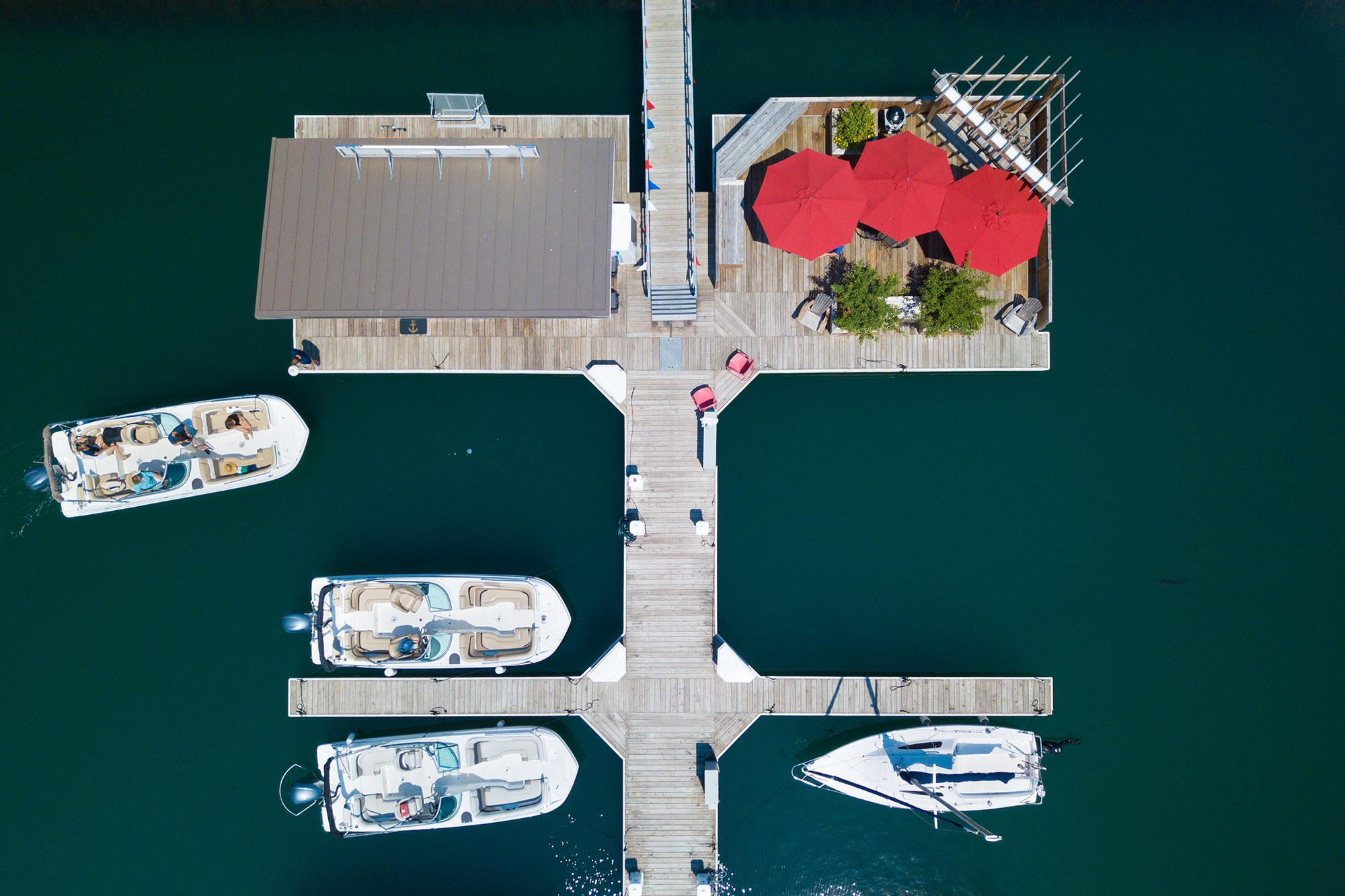
Docking a boat can often be intimidating and stressful, especially for those just getting started with boating. Luckily, learning how to dock a boat doesn’t have to be difficult, and boaters new and old can quickly master the task by following a few simple steps.
How to Dock a Boat
- Prepare dock lines on your bow and stern and attach fenders.
- Line up your approach and survey the docking area.
- Judge the current, wind, and water conditions.
- Take your time, proceed slowly towards the dock using intermittent acceleration.
- Never approach a dock any faster than you’re willing to hit it.
- Navigate into the boat slip or turn to come alongside the dock.
- Tie off your boat onto cleats, posts, or pilings using your docking lines.
It’s as easy as that! It can also be useful to have a friend or family member onboard or on the dock to help assist you throughout the process. If you’re docking by yourself, remember to take it slow and don’t be afraid to stop, pull back, and circle around to try again. Place your fenders ahead of time and have your docking lines ready to tie off as soon as you’re in close proximity to the dock.
Now, let’s get into some specifics about docking a boat in different situations.
Docking in a Slip
As a boater, docking in a slip is a common scenario you’ll often find yourself in regardless of whether you are docking in your own personal slip, a friend’s slip, or at a public marina or dockside restaurant. Before you begin, we highly recommend having your docking lines and fenders ready ahead of time on both sides of your boat. As in any and all docking situations, you’ll then want to start by checking your surroundings —look out for other nearby boats and be conscious of the conditions of the wind, water and current.
Next, always maneuver at a slow speed . Within a slip, you have limited mobility, which means you have little room to make mistakes. In most cases, you’ll want to position your boat so you’re able to back into the slip . Before you start backing in, you’ll want to center your wheel .
Slowly reverse your boat into the slip . Do your best to keep your balance and tell your passengers to stay seated during the process. This is not only for their safety, but it can help to keep the boat steady as it moves into the slip. Apply one last small burst of power forward to stop your reverse momentum . Then, tie off your lines to the dock. We suggest having two bow lines and two stern lines tied onto both sides of the slip—with the stern lines crossed.
Docking a Pontoon Boat
When it comes to docking a pontoon boat , there are a few factors to keep in mind that differ from docking other types of powerboats . While you’ll still want to concentrate on maneuvering at a slow speed, you’ll want to pay even closer attention to the wind and current conditions . The wind has the ability to completely push your pontoon off track during a docking situation—or worse, push it into the dock itself. If you have a strong breeze present, you can counteract this with small, controlled bursts of acceleration. Likewise, don’t be afraid to use reverse to stop any unwanted forward movement of your boat.
Particularly when first learning how to dock a pontoon boat, you may want to enlist as much help as possible and have someone on land guide your boat alongside the dock or into the slip. You can also be proactive by preparing your docking lines and fenders ahead of time .
Lastly, you’ll want to get to know your boat . For example, how much acceleration do you need to make a complete turn at a slow speed? How sharp can you take a turn? Just like cars, every boat is unique and the more you practice, the better you’ll get at overall handling and docking.
How to Tie a Boat to a Dock
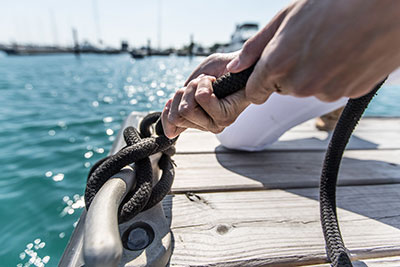
When it comes to docking equipment , you’ll want to keep a large supply of docking lines on hand. These docking lines, also known as mooring lines, can be used in a few different ways and can be referred to as bow, stern, spring and breast lines. In most cases, you’ll only be utilizing your bow lines and stern lines . The final piece of equipment you’ll want onboard are fenders, sometimes called “bumpers.”
When tying off your boat, you’ll usually be docking in a slip or alongside of a dock. In either of these cases, you’ll find cleats or pilings . Cleats are small, t-shaped equipment that are usually made of steel or some kind of metal that is attached to the dock. You also have similar cleats on your boat that you’ll use to attach your docking lines. Pilings, on the other hand, are large wooden posts that you would commonly find on a pier or positioned recurrently along the dock. Whenever possible, you’ll want to tie off your boat to the dock using cleats rather than pilings, for the simple reason that tying off on a piling can sometimes be more challenging.
When it finally comes time to tie your boat to the dock, there are a few common knots you can use to secure your lines: the cleat hitch , the clove hitch , and the bowline knot . Be sure to visit our Discover Boating YouTube channel to check out our videos on Boating Knots 101 .
Read Next: How to Tie Up a Boat
You Might Also Like:
- Anchoring a Boat: Step-by-Step Guide
- How to Navigate a Boat
- Boat Buyer's Guide
- Owning & Operating Resources
- Explore Different Boat Types

Join Our Newsletter!
Get community news, buying bargains, and how-to guides at your fingertips.
Top 5 Docking Videos
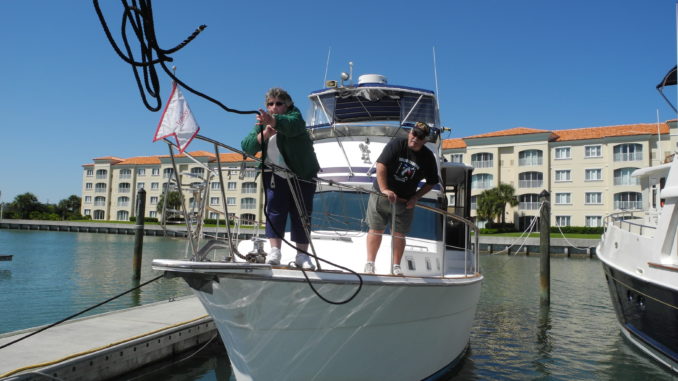
Docking – Fear not!
Most boaters have a few rational concerns that can easily be overcome with the right tools. Docking is right up there as the greatest fear and quite frankly, it is the easiest of all fears to meet head on. It just takes learning the right way first and then practicing, again and again. It’s a little tough to break bad habits, right?
Featured in this post is our Top 5 Docking Videos for you to enjoy! And although we primarily focus on powerboats, the sailboat owner has to dock sometime. And most will use their engine to come into a slip.
Free YouTube Channel
Take a look at our Ask Captain Chris YouTube Channel and you will find a simple and free way to learn more about docking. Every day we post a short, unedited video of real-world cruising information. Sometimes it’s just a two minute clip showing a beautiful boat underway, an engine room tour or a look at what went right during a docking maneuver. In a few other instances we show you what not to do even if it’s simply to stay put if the tide is running.
If you are new to our YouTube channel then you may want to poke around a bit and check out our Playlist videos that are grouped together in similar topics. Feel like watching others Dock ? are you considering traveling with Pets Aboard ? Or maybe you want to learn more about all the Below Deck Systems ? If you do, we have hundreds, yes hundreds of mini-movies for you to learn more about your boating adventure.
Learn About Docking
While we are sharing links to only 5 of our Docking videos, when you go to our YouTube channel Docking Playlist you will find over one hundred and thirty-five Docking video clips to learn from. While most videos are only two to three minutes you will find something interesting about docking correctly in each and every clip. But, there are a few that are a bit longer because they show what to do when you miss your first try, or your second try too. So without further ado, click on 5, 4, 3, 2, 1…
#5 Docking Video – SeaRay Docking in High Winds . A big SeaRay docking in high winds at Tidewater Marina in VA. Watch the procedure and consider his decision to bow into the slip. Its was a good move understanding the conditions.
#4 Docking Video – Single Engine Docking. Watch this new boat owner dock his single engine Mainship into the slip near White Rocks in the Chesapeake Bay. The high speed engine you hear running is the generator.
#3Docking Video – Gold Loopers Before and After. Captain Chris helps these loopers get started on their great loop adventure. This 5 minute clip shows their first docking and one year later captures their excitement as they finish the loop. It’s your turn next…but a little practice can’t hurt!
#2 Docking Video – Nordhavn 47 Leaving with the Tide . Practice and patience makes leaving the dock simple and easy, even on this BIG Nordhavn trawler! By resetting lines the mate can do it all without the help of marina staff- makes the Captain look sooo good even in tight spots.
And the number ONE Ask Captain Chris Docking video from our free YouTube Channel is…..
#1 Docking Video – Docking in High Winds . Practice in calm weather so you know how to power your engines (and thrusters if you are lucky enough to have them- this boat did not) BEFORE you really need to. And pay attention to other factors such as wind deflection from buildings, other boats and docks. And if you have the time you might poke around and read ALL the comments- some positive, some clueless and some are downright snarky. My favorite comment from a viewer addresses the keyboard captains who can always do it better. If you are a seasoned boater then you’ve been in less than ideal situations…This captain did the right thing- try, try, try again. Slow and steady wins the race!
Dock with Confidence
Not sure what these topics are all about or how you can dock with confidence? Get our 60 minute Docking video to watch with your crew. Ask Captain Chris in our INTRODUCTION TO BOAT SYSTEMS or CRUISING 101 FUNdamentals Seminars in Vero Beach Florida. Give us a call 772-205-1859
So don’t forget to subscribe today to our YouTube channel so you don’t miss out.
Phone: 772.205.1859 | [email protected] | Copyright © 2006 - 2023 Captain Chris Yacht Services LLC. All rights reserved.
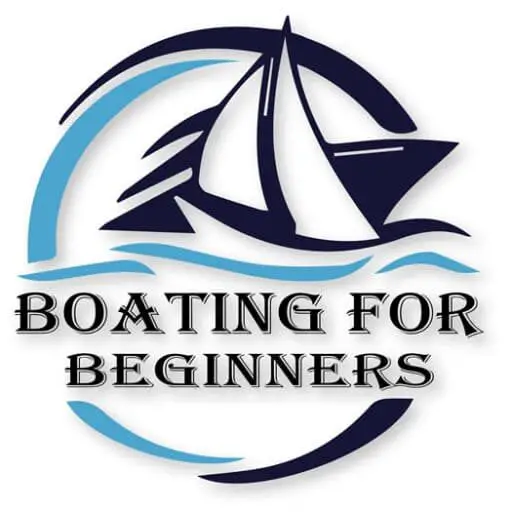
Docking a Boat For Beginners and What You Should Know
Docking a boat for the first time is probably one of the more nerve-wracking experiences you will have to endure as a boater. I bet practically everyone you talk to will tell you how easy it is to dock a boat, and well, for the most part, they will be right. It really is an easy task as long as you know what you are doing.
I’ve put together a guide below in this article to help explain how to dock a boat so that when you try it for the first time it won’t feel as overwhelming.
Steps For Coming Alongside a Dock
Step 1: line up the approach.

Step 2: Keep It Slow
A common mistake that most new boaters make is that they come in way too fast. As you are approaching the dock, use your forward and reverse gears to help maintain the proper speed you are looking for. On a twin-engine vessel, you can switch back and forth between the engines to help you slowly come in.
Step 3: Swing Your Boat In

Step 4: Finishing Touch

Step 5: Secure Your Boat
With the boat sitting parallel to the dock, you can now turn off the engine and begin to secure it to the dock. Once the boat is secure, you can begin to let off or let on your passengers.
How To Dock a Boat With a Single Engine
Usually, docking a boat with a single engine is the easiest thing that you can do. The first thing to focus on here is to get the dock lines pre-rigged. At this time you want to have the fenders set and also hung over the side.
It’s a good idea to study the current orientation, as this might end up affecting your docking experience. Make sure that you handle the bow of the boat adequately so you can eliminate the wind force. Ideally, you want to have more control, and that means going against the wind or water currents.
If you have crew members, you want them to be at various strategic spots. These include the stern and the bow, some should even be at the dock lines if possible. Your crew should never put their feet or hands between the boat and any other item, as they can end up with some major injuries. So you need a lot of attention and focus, otherwise, you will end up with problems.
As you get closer and closer to docking a boat, you need to line it up for the approach. Slow down but maintain steerage if possible, as that will work a lot. You can also lower the canvas enclosure, sports towers or the bimini tops, as that will help you reduce the wind effect. It will also give you more control over the boat, which is what you need in a situation like this.
In case you see that the wind or currents are pushing you against the dock, you want to make the entry as shallow as possible (degrees). It’s important to increase the angle of attack when the weather is good and there are no currents. Don’t move with the wind if you want to get the utmost control, so try to keep that in mind at all costs. Slowness is key if you want to start docking a boat the right way. Make small adjustments as you get closer and closer to the dock.
A good trick that most people use is to put the engine into and out of gear. If you see any issues, abort the docking procedure and try again. The last thing you want is to deal with are any major issues.
In order to complete the process, you will have to stop the forward momentum of the boat. You can do that simply by delivering a tiny bit of power in reverse. The attempt is to stay in a line if possible. Angle the engine at the dock and then make the reverse approach if possible. Tie off and ensure that the dock lines are set, this way you can be sure that you won’t come in contact with other boats. Shut down the engine only when the boat is 100% secure. Otherwise, you will end up dealing with problems.
Secure the lines and make sure that the ropes are put in tight. Since this is a single engine boat, you don’t need to use lots of ropes, but the more you use, the more secure your boat will be. So try to keep that in mind.
How To Dock a Boat With Twin Engines
If you use this system, the boat is pivoting on the axis. You can put the port engine in reverse and the starboard engine in forwarding movement. When you do this, you will notice that the port engines pull the bow of your boat to the port and the starboard engine ends up pushing the stern to the starboard. It’s still a great system for you to try out and it can actively work well if you handle it appropriately.
Docking a boat with 2 engines is great because you also have an outboard, outdrives or twin inboards with rudders. It’s a good idea to center the steering wheel as the engines will do all the work. The inboards will pivot a boat a lot faster when compared to the outboards. If you use the outboards, you will need to add more power if you want similar results. Which is why using the inboards is a lot easier. But it’s up to you to experiment and see the right approach.
If you get close to the dock, you want to alternate the power distribution as you try to keep everything under control. The trick here is to practice this and apply power to the starboard and the port engines adequately. If you pull alongside, you want the engine that’s farther from the dock as you try to pull the stern in.
Using a single engine or both in tandem is a great idea. But it does require experimentation, mostly because stuff like this can be very difficult to manage and handle. Yet it does have the potential to work very well if you know what you are getting into with stuff like this. So yes, it doesn’t matter if you have 2 or more engines most of the time. Usually, if you have more than 2engines, you will notice that they are paired electronically on the outer engines. However, some models do allow you to configure stuff through the engine controls too. And that’s incredibly interesting and rewarding.
Docking With Thrusters
The thing to consider here is that most of the modern stern and bow thrusters have their own controllers. There are some units that have a controller in the form of a joystick. The appearance of that controller doesn’t really matter, it mostly comes down to how comfortable you are when it comes to using the controller.
Speaking of that, the controllers will use a green arrow to showcase the direction according to how you maneuver the joystick. A good idea here is to use the thrusters sparingly. You want to use them as the means to correct any possible issues if you can. That will make things a lot easier for you, otherwise, you will end up with some issues here and there. Remember, you can always add more power, but if you add too much power, you end up losing control. So it’s a game of patience and focuses more than anything else.
Then there’s the fact that some of the thrusters and more particularly the electrical ones will shut down for a bit or overheat. Which is why you need to use this in short bursts. The chances of dealing with any kind of problems with this sort of thing are pretty much minimal, so try to consider that.
In the end, it all comes down to experimenting and finding the right system and approach that works for you. Sometimes it can be a simple one, other times it can be very difficult. The idea is to study everything and then experiment to see what’s comfortable for you.
How To Dock a Boat In a Tight Slip
If you have to dock in a tight slip, this will complicate things a little bit. The idea here is that a slip is not a very open space. Docks are open on 3 sides, but the slip just has the pier, and that can make it difficult. Show your companion the mooring line and the eye of the line. You want to show the spot that will be placed over the boat’s cleat and explain how you want to pull this thing off. It might end up being a challenge, so try to consider that.
What you want to do is to lower the speed to the point where you have bare steerageway. You want to go slowly, but not too slow as that can be an issue. If you slowed down to the right speed, go to the pier at a 45-degree angle. If you are close to the pier, go into neutral. Shifting the gears and going into neutral is what you want to do if you want to handle the process correctly and potentially avoid any problems.
Now that you are moving, you want to shift the boat away from the pier, drop the eye of the line and now move around 2-3 feet from the pier as you shift the motor ahead just a tiny bit. You want to tie off the cleat to the bow of the boat. Do that and then you will be docked.
Tips To Dock a Boat Safely
If you have twin inboards, don’t touch the wheel even if you are tempted. Lower the windage if you are dealing with winds, regardless of their intensity! It’s also a good idea to make sure that you never kill the engines until all the lines are secure. Otherwise, you can end up with problems.
That’s why it should always be ok to abort and try again. You should never rush just to try and get this right. It might work right off the bat, or you might need multiple tries to pull it off. The idea is to know what you are getting into and focus on making this a great experience. It’s all about precision more than anything else.
In the end, docking a boat is only as hard as you make it be. Yes, it won’t work right away and you might have to try it out multiple times. But this is a game of patience and precision, and as you get more experience you can get very good at it. That being said, don’t hesitate to use all the tools and features offered by your boat when it comes to docking. It will enable easier and faster dockings, plus you will avoid any potential damage to your boat as well!
“ never approach a pier any faster than you’re willing to hit it”
Recommended
Launching a Boat For The First Time – What To Do and Not Do

Similar Posts
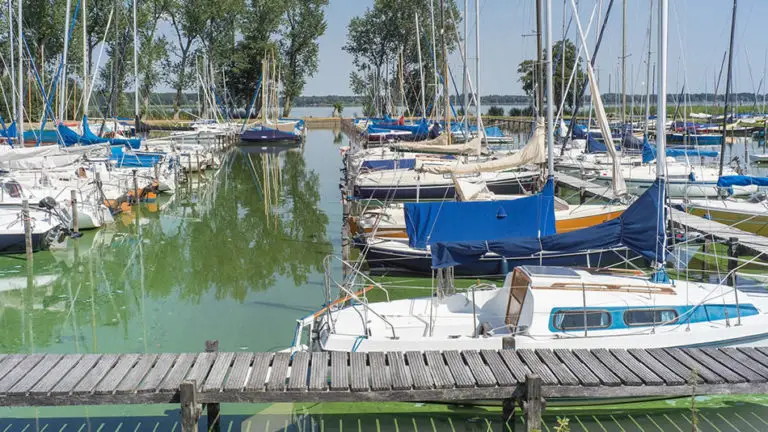
How To Get Rid of And Prevent Algae on a Boat
I have to admit; I didn’t know too much about algae until I began researching it. I figured if my son were going to be coming out on the water with me, then I’d better learn more about it and make sure it wasn’t going to be harmful to us. As it turns out, there…
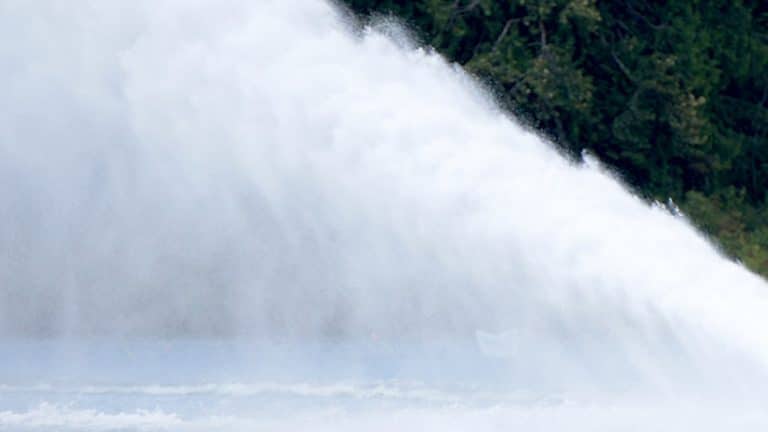
What Is a Boat Rooster Tail and How You Can Make One
The term rooster tail is used in fluid dynamics, meteorology, and automotive gear shifting. But in this article, we are going to talk about rooster tail related to fluid dynamics. In fluid dynamics, a rooster tail lies directly in the wake of an object such as a boat traveling within the water and is accompanied…
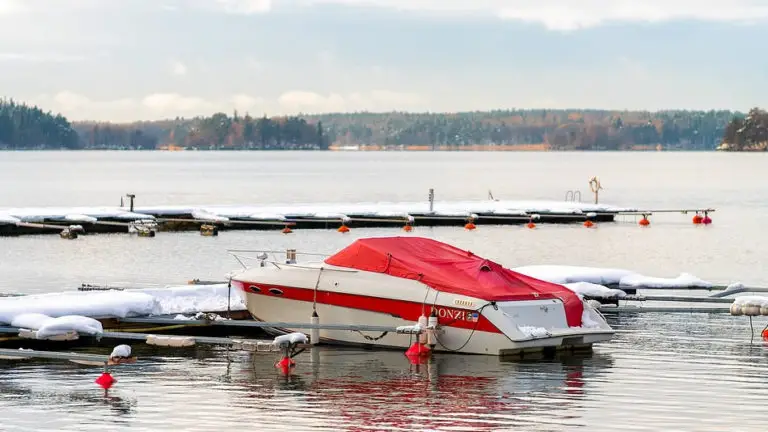
Everything You Need to Know for Winterizing a Boat
With winter right around the corner, the cold air will soon be taking over, causing temperatures to drop below freezing for half of the country. But before that happens you need to make sure that your boat is ready. Without properly winterizing your boat, you run the risk of water freezing and causing the engine…

Everything You Should Know About Boating With a Dog
If you love boating and you’re a dog lover, then you might want to learn how to go boating with a dog. It’s a fun, great way to spend your time with your beloved pet. My son has been asking for a puppy for about 2 years now, and this Christmas we are going to get…

Helpful Tips For Towing a Boat
Every boat owner knows that being able to take your boat everywhere you want is a privilege and a great way to spend your time. However, there are specific rules you have to abide when you want to tow a boat. Some states require special trailer brakes especially if the boat has more than the…

Starting Boat Motor Out Of Water
I’ve heard a lot of boaters talking about how they start their inboard or outboard engine while the boat is on land so they can test the motor before they have it on the boat launch. That got me wondering how safe it could be for the engine, so I did some research. As it…
- Skip to primary navigation
- Skip to main content
- Skip to primary sidebar
- Skip to footer
Sailing Eurybia
Two Humans and a Dog sail Mexico on a Sea Maid Ketch
Tips for Docking a Sailboat Safely and Confidently
April 18, 2019 10 Comments
I grew up in a sailing family. I learned by example from my dad, then by experimentation after that. Since our early boats had no engines (nor did they go in reverse!) I did not learn about docking except how to sail a tiny light boat up to a dock and turn into the wind. Not much use for our 32,000 pound 45’ boat! Ever since I had been docking by winging it – and sometimes winging the bow pulpit. I successfully docked in most situations, but it was always nerve-wracking.
Finally I have had an opportunity to change that. I took my first ever ASA class here in San Francisco and learned techniques I would not have thought of, plus got confidence by doing it myself. The Advanced Motoring & Docking class as taught by Tradewinds Sailing School in Richmond, CA is fabulous. At first I thought it seemed expensive at $325. However it’s a full day on the water and the in-person instruction was fabulous. There were just two of us in the class and we used a Jeanneau 43 for the day. I learned so much about controlling the boat in tight quarters WITHOUT jumping off the boat or doing other dangerous and unnecessary actions. Although they test on the ASA information, they also introduce their own methods which, I have to agree, seem far better than the traditional approaches.
I will share with you some of the information I learned, but of course my notes are only to pique your interest and maybe give you some hints for your own docking. I strongly recommend that if this interests you that you find a course yourself, but you might ask if their methods require jumping off the boat to catch lines when docking. Tradewinds methods have convinced me that this is a dangerous and unnecessary practice, despite being the most commonly seen. Tradewinds trains you to stay on the boat, keep the boat under control, and step off the boat to tie dock lines only when the excitement has ended, the boat is stopped, and it is safe to do so slowly.
Motoring Concepts
Moving a boat under power has six elements that you have to balance or learn to work around. Wind and Current clearly can affect how the boat behaves. Prop Walk and Prop Wash are two ways that the boat’s motion is affected by the propeller action. And finally Momentum (how much way you have on) and Inertia (the tendency to keep moving in the direction you are already going, even when the engine is in neutral) are two more forces that can be used as tools to controlling the boat by power. These influences are probably familiar to you but we’ll run through them quickly.
Wind and Current
Current tends to affect the whole boat, making it move downstream in generally a straight line. It can also be hard to see until you suddenly realize you are going to miss the slip you were aiming for.

Wind tends to affect the bow most quickly, making it trickier to move the bow into the wind without it blowing off. But this means that reversing into a wind is often easier than powering forward into a head wind. Useful to realize that.

Momentum and Inertia
Momentum is the amount of force your boat has based on its speed and weight. Momentum is why you want to have control over speed – as they say you should approach the dock at the speed at which you are willing to hit it. Inertia is the tendency to stay moving a particular direction. Inertia will be essential in fighting prop walk – read on!
Prop Walk and Prop Wash
Prop Walk is the tendency for the boat to turn in a particular direction when reversing. Most boats have a right-hand turning propeller which forces the stern to the left when in reverse. Left-hand propellers would do the opposite. In the following paragraphs I will default to a right-hand turning propeller but I will try to remember to put notes in parentheses e.g. (LH: steer left) for those with left-hand drive props.
How do you know whether you have a right-hand or left-hand drive? If you have tried to reverse you may have noticed that it curled off to one direction or another. But if you have a new boat then you can check this at the dock when tied off securely. Put the engine in forward with moderate throttle. On one side of the boat or another, just aft of amidships, you will see agitated water. The other side of the boat will be calmer. This agitated water is the result of Prop Wash as the propeller blasts water off the keel. For a boat propeller that turns to the right, clockwise, (when viewed from astern) the prop wash will appear on the starboard side (and your boat will reverse to the left). If you see the turbulence on your port side you have a left-hand drive, your boat will reverse to starboard, and will need to follow the (LH: xxx) instructions.
Whichever direction of Prop Walk your boat has, transitions to neutral will allow the boat to keep moving backwards without continuing to turn. Short bursts in reverse will apply more power to keep moving backwards, but once you get way on again, pop into neutral to counteract the turning.
Going into neutral allows the boat to stop exhibiting prop walk while still moving in the direction you were going the moment you slipped out of reverse.
Use Minimum Motions
Big motions get you in trouble on a boat. Tiny adjustments are often enough and easy to counteract if you went the wrong direction. A 6” turn of the wheel is plenty – do a little and watch. Likewise just changing gears is often enough, you may not need to throttle up to change the motion of your boat. Change gears first, then throttle up slowly if you still need the power. Occasionally you will need to give a burst of throttle, but it still does not need to be a large change, just quick.
Note: If you have a throttle and a gear shift (my boat has a single handle for both functions) then don’t forget: Forward – Neutral – Reverse – never go straight from Forward to Reverse, always pause in Neutral to avoid transmission damage.
Remember A Boat Doesn’t Drive Like a Car
My very first cruising boat was a homemade beauty that had some, shall we say, peculiarities. One of these was that the steering system was from a car. The steering wheel was a smallish car steering wheel and it was hooked up backwards – you turned left to go right – sort of like a tiller. Boy did I get confused when trying to back up! I assume you don’t have this issue on your boat. However notice that this entire article assume you have wheel steering. For tillers a right rudder is effected by turning the tiller LEFT, whereas a steering wheel (usually) is turned right to effect a right rudder.
In some ways a boat DOES turn like a car: When you are going forward (assuming sufficient speed) and turn the wheel to the right your boat starts a right turn in a gentle arc. If you were to reverse (assuming sufficient speed) it would follow that same arc in reverse (until you slow enough for prop walk to affect your boat’s motion).

Whether going astern (with sufficient speed) or ahead the boat tends to travel along an arc. The left image above shows the path when the rudder / wheel is turned left and the right image shows the path with right rudder / wheel.
However, unlike a car, a boat turns about a pivot point aft of the main. So when the bow moves to the right in a turn, the stern is swinging out to the left.

If you’re turning a boat your stern can hit a pillar which the bow cleared just fine – check your stern and turn when it is safe for the stern to swing out.
Also be aware of Advance which is much greater in a boat than in a car. Advance is the distance before the opening that you need to start your turn (when entering forwards). Our instructor told us that for the 43’ boat we were sailing that we needed to start the turn into the slip about 62’ out – about 3 of our marina’s 21’-wide slips before the slip we were going into. Remember that the helmsman determines when to start turning so the advance distance is properly the horizontal distance from the helm station to the center of the slip you are going to.

Other sources say to turn when the opening is 30 degrees off the direction of your boat. Try these methods until you are comfortable turning into your home slip and you can estimate a similar distance or angle when going into an unfamiliar marina.
Docking Techniques
Note that these docking techniques are different than most of us are taught in two ways:
- no one jumps off the boat until the boat is stopped next to the dock
- you do not throw lines to people on the dock, instead you stay in control until stopped then step off the boat
This may be heresy to you and other captains you sail with, but it is much safer for both your crew and your boat.
Some Techniques to Practice
If you think of docking as being done 75% in neutral you won’t be far off. Neutral has the great advantage of taming prop walk and utilizing momentum effectively. Of course you have to use forward and reverse to get anywhere, but think of forward and reverse as momentary “correctors” that just increase your momentum or change your direction.
In some of these maneuvers you will want to have a “loop” prepared to help control the boat when you arrive. An aft spring loop will be a mooring line secured at your aft cleat and your waist (midships) cleat with enough slack to nearly touch the water. It will be used when heading forwards along a dock.
A forward spring loop is similar – a mooring line secured at your bow cleat and your waist (midships) cleat with enough slack to nearly touch the water. It will be used when backing onto a dock. In both cases you want there to be enough slack that the crew can pick up the slack in two hands and toss it over a cleat on the dock when the boat is nearly stopped and in good control close to the dock. The boat will back down (forward spring loop) or move up (aft spring loop) and get sucked into the dock with no need to use (unreliable) bystanders or dangerous leaps to shore from a moving boat. See more detail in Parallel Approaches below.
Back-and-Fill or Standing Turn
A standing turn, changing direction or “spinning” in place, also called Back-and-Fill is a useful technique. You can practice this is an open area, or for best results, in an empty mooring field where you can really mark your starting position. For a RH Drive boat you will put your wheel all the way to the right (LH: Left wheel) and lean against it to hold it in place – you will not be turning the wheel again until you’re done . Go forward and proceed slowly on your turn. When you are starting to move away from your starting position, go into reverse, where you will be helped by prop walk as well as the rudder angle. Once you start to go backwards rather than just turning, shift back into forward and continue alternating forwards and reverse until your boat is facing the new direction. Straighten your wheel to proceed.

The Standing Turn or Back-and-Fill. The dark line out the back represents the rudder/wheel position and the pink arrow indicates direction of travel. By alternately reversing and going forward you can turn your boat in place.
Where do you use this?
- preparatory to backing into your slip
- turning in a fairway when you are headed the wrong direction (oh – the fuel dock is over THERE!)
- any time you need to turn the boat around and have limited space to do it
- showing off for your friends
Perpendicular Forward Approach
Say you are approaching the fuel dock. It is directly in front of you. You are going to need to turn to come parallel to it. How close do you get before turning? A rule of thumb is approach until the bow of your boat appears to be at the same level as the dock you are approaching. This is a rough guide, but much easier than trying to guesstimate when you are, say 62’ away. Then once you are parallel to the dock proceed as for Parallel Forward Approach below.
Parallel Forward Approach
This is probably the most common way to approach a pump-out or fuel dock when there is plenty of room to do so. When you can approach from either side equally then plan to approach port side to the dock (LH: starboard side to the dock) so you can use prop walk in getting off if needed. Prepare an aft spring loop on the port side (LH: starboard side) as described above. Approach slowly in forward gear from a ways out, turn 30 degrees to the dock until you judge you are getting close, then straighten the wheel. You should be in neutral by now. Make adjustments (reverse if you’re going too fast, forward if you’ve lost way) and slow down until you are stopped or nearly stopped a few feet away from the dock. Ask the crew to toss the aft spring loop onto a cleat. Then pop into forward with very low throttle and turn the wheel away from the dock. The boat will be sucked into the dock and held there so that crew can safely and slowly disembark. If you need to do a lengthy fuel up or need to take your boat out of gear for another reason then the crew can secure the boat normally with mooring lines. Otherwise you can just stay in gear while you pump out.

Aft Spring Loop – Forward Gear – Turn away from dock
Parallel Backwards Approach
This approach is very similar to above but you will be backing in and using a forward spring loop. The preference is also to land on the port side (LH: starboard side) In this method but you can approach with either side to the dock in good conditions (little wind or current). Once the spring is deployed, pop into a gentle reverse, and you will be sucked into the dock and against the spring line.

Forward Spring Loop – Reverse Gear – Rudder not significant
You can also use this method if you are going in forward but the only cleat is ahead. Then you can use the forward spring but change into reverse and go backwards to secure yourself against the dock.
Wind Conditions
Wind on your bow is destabilizing – the bow can blow down and it is difficult to control the boat. However moving your stern into the wind is actually easier – the bow tends NOT to blow off when the stern is into the wind. You do have to contend with prop walk, but you have been given ways to deal with that.
So if you are approaching your slip on a very windy day these are the easiest ways to approach:
- back in if the wind is coming out of your slip
- go in forwards if the wind is blowing into the slip
Especially if others are watching! Why make it harder?
Backing in with wind ahead
But if you do need to back up with the wind from forward and your bow is tending to blow off, it gets confusing knowing which direction to turn. Rather than try to wrestle through the logic, just turn in the direction you DON’T want the bow to go.
If backing up and the bow starts to fall off to starboard, turn starboard. If it starts to fall off to port, turn to port. Little turns, a few inches.
Why does this work? Remember that when in reverse the stern turns to the right when the wheel is right, which means the bow turns to left.
Backing Out of the Slip – Basic
The most basic idea about leaving the slip is to plan for where you want to end up. You always want to end up on the windward side of the center line down the fairway heading towards the exit. For those with a fairway exit opposite the direction their prop walk takes them, well, you may need to back down the fairway and you should become comfortable with this. You can also use spring lines or warps to get your boat turned opposite the prop walk direction, but that is beyond the scope of this article.
Wind Coming out of the slip
The wind will assist getting out of the slip but you need to take a fairly tight turn so that you stay on the windward side of the slip and don’t blow down on the boats across the fairway. You may need a spring line on the outer leeward side of the slip to help you turn.
Wind Blowing into the slip
When the wind is blowing into the slip it’s essential to reverse a little more forcefully to get out of the slip, but you can take a wider turn so as to end up on the other side of the fairway. You will need to make sure you can get your bow around so that you don’t get blown back down onto the pilings around your slip. So as soon as you are out of the slip and are crossing the center line of the fairway forcefully turn the wheel towards the wind, shift into forward and give it plenty of throttle to get that bow moving.

I hope these notes give you a few more ways to think about docking. I haven’t talked much about using lines to further control your entry to or departure from a slip – that’s the Advanced Advanced Class! Likewise maneuvering around other boats on the docks you are approaching. But in good conditions and without other boats around these methods will work with no additional measures. So practice these docking techniques until you are confident entering and departing your slip in good conditions, and you can approach the fuel dock with confidence. Good Luck and Be Calm.
Share this:
- Click to share on Twitter (Opens in new window)
- Click to share on Facebook (Opens in new window)
- Click to share on WhatsApp (Opens in new window)
This site uses Akismet to reduce spam. Learn how your comment data is processed .
Brilliant! There is so much good information in this post – I’m so glad to see it. Would love to see your take on getting in and out of docks when maneuvering between other boats that are already tied up. Also your favorite engineless docking thoughts. But in the meantime, those spring loops really are special – wonderful to learn some new stuff about this! Cheers, Shemaya
Thank you! I’m so glad you found it useful. And yes, coming into, say, a fuel dock when there are already other people tied up would be a great follow-up topic. And engine-less docking, something we used to do frequently when we had a boat with a less reliable engine (!) is something way too few people learn to be good at. My current slip nearly always has stiff breezes straight from the Golden Gate Bridge blowing into it so I think I would have to line in for safety. Another good topic! And then anchoring under sail – everyone … Read more »
Hi Marie, All of that sounds great! I’d be fascinated to hear your take on anchoring and sailing off of anchors without motors. I’ve read various versions, and have what I do, which doesn’t necessarily match up with recommendations, but has worked for me… I haven’t actually written that up. When you say “lining in,” you mean setting an anchor so that you can let the boat fall back under control? I’d be really interested to hear details about that, especially about how you manage the anchor and line after the boat is in the slip. It’s not something I’ve … Read more »
Maybe “line in” isn’t the real term — I just meant that I’d have to use lines to control the boat without an engine if there were a stiff breeze straight into my slip. You’re right though – in severe conditions without an engine using an anchor to control your speed might work – but then you’d have to go get the anchor with the dinghy. Ok for an emergency but wouldn’t do that as a routine. But we’ve also used our (powered) dinghy on the stern quarter to move the boat when there were no winds and the engine … Read more »
Thanks for your suggestion to slightly and/or quickly adjust the steering wheel to get the desired direction instead of using big motions. My husband and I are looking into buying a sailboat this summer, but I don’t have a ton of experience with driving one. He’s been giving me a lesson or two on our friend’s boat, and I’m slowly improving, but this tip helps a lot. Once I get good at this, we’ll need to look into getting a boat and a dock so we can more fully enjoy the summer.
And heavier boats take some getting used to – you have to turn a little and wait for the boat to react. Good luck! It’s a great skill to have and makes your time on the water much more relaxed. Enjoy.
Great article. Thanks for summarizing the tricks and pointers. Very helpful
Thanks, Jim! So glad it was useful to you.
This may be the most helpful article I’ve read on sailing. You explained several things well but briefly which made it more clear. I especially appreciate the explanations of spring loops. We recently saw a boat tied up this way and we’re curious, but didn’t ask. I also very much appreciated the point that the boat should be stopped before jumping off. It’s typically just my husband & me and I am very anxious about jumping and not very good at jumping off to tie up. I feel so much better about it now and will definitely try the spring … Read more »
Thank you Greta! So great to hear that knowledge that helped me is helping someone else! I typically steer the boat just because of the jumping off thing, and my husband ended up in the drink more than once! But now we have a safer way, I’m glad you do, too.
Stay in touch - sign up for our newsletter for occasional news from Eurybia and her crew.
Your Boat Name:
Email address:
- Privacy Policy
“Live in the sunshine, Swim the sea, Drink the wild air” --Emerson
About This Site
SailingEurybia is a WordPress site. The theme is a version of the Genesis Sample Theme developed by Eurybia-Marie . ©2018
- 2024 BOAT BUYERS GUIDE
- Email Newsletters
- Boat of the Year
- 2024 Freshwater Boat and Gear Buyers Guide
- 2024 Boat Buyers Guide
- 2024 Water Sports Boat Buyers Guide
- 2024 Pontoon Boat Buyers Guide
- Cruising Boats
- Pontoon Boats
- Fishing Boats
- Personal Watercraft
- Water Sports
- Boat Walkthroughs
- What To Look For
- Watersports Favorites Spring 2022
- Boating Lab
- Boating Safety
- Ultimate Boat Giveaway

12 Top Docking Tips
- By Boating Staff
- Updated: June 23, 2017
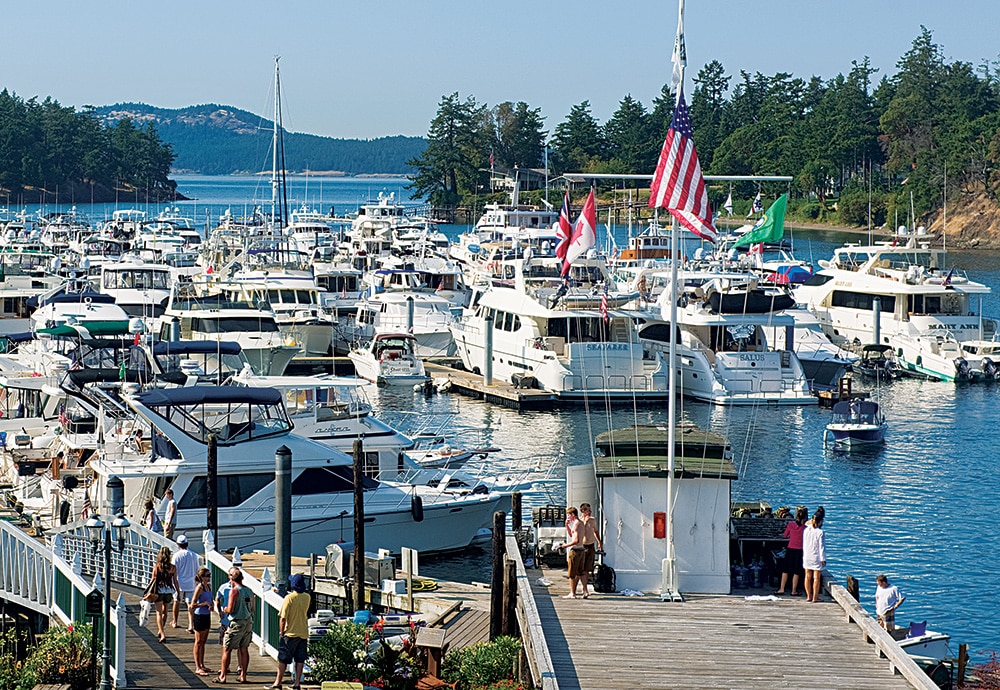
Here are 12 tips that will not only make you better at close-quarters maneuvering and docking, but will also make you a better all-around boater. Remember, the cardinal rule of docking is never approach the dock faster than you are willing to hit it.
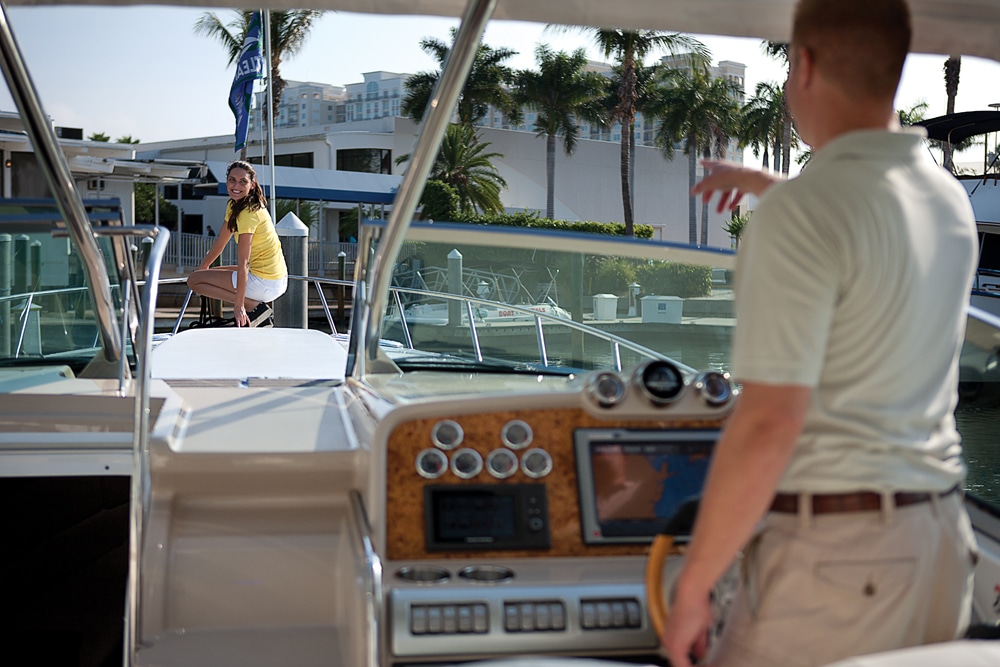
1. Come Up With a Plan First and foremost, you must be aware of how your boat handles, particularly at bare steerageway. The more comfortable you become, the more confident you’ll be when trying to slip it into a tight space in a jammed marina.
10 Simple Rules for Better Docking
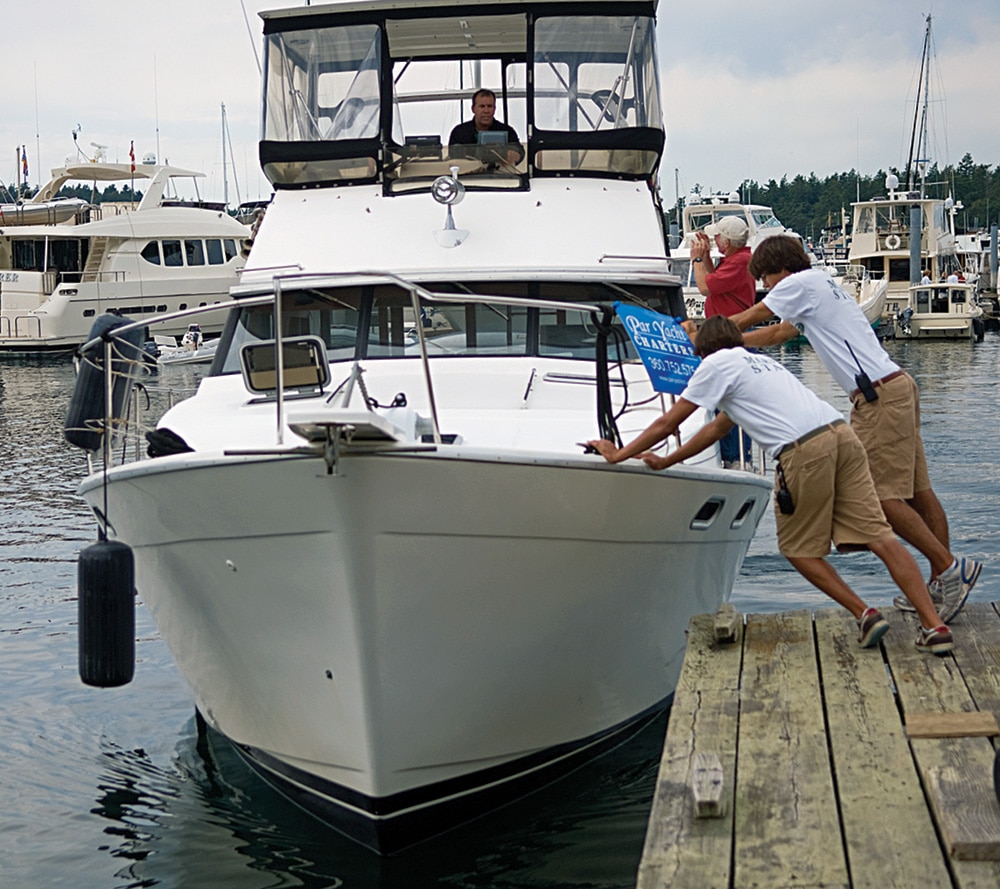
2. Learn How to Use Wind and Current to Your Advantage When docking in a tough spot, wind and current — coupled with knowledge of how they affect your boat — plus situational awareness can serve you better than an army of deck hands.
How to Use Wind and Current When Docking
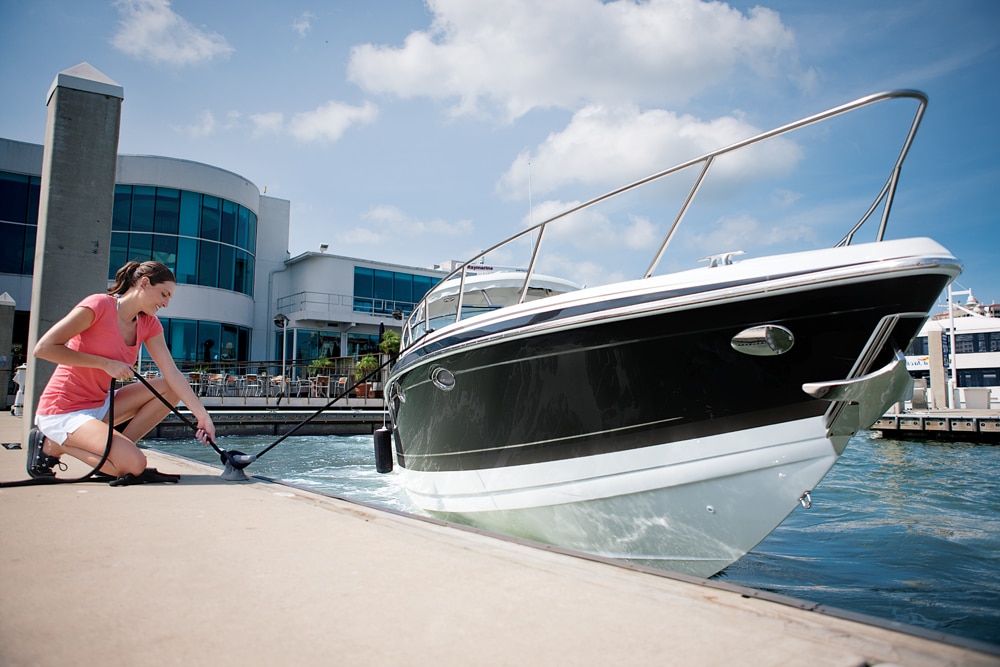
3. Dockmaster Docking Tip The first line to toss is your spring line, with loop fed through your boat’s cleat.
12 Tips From a Weekend Dockmaster
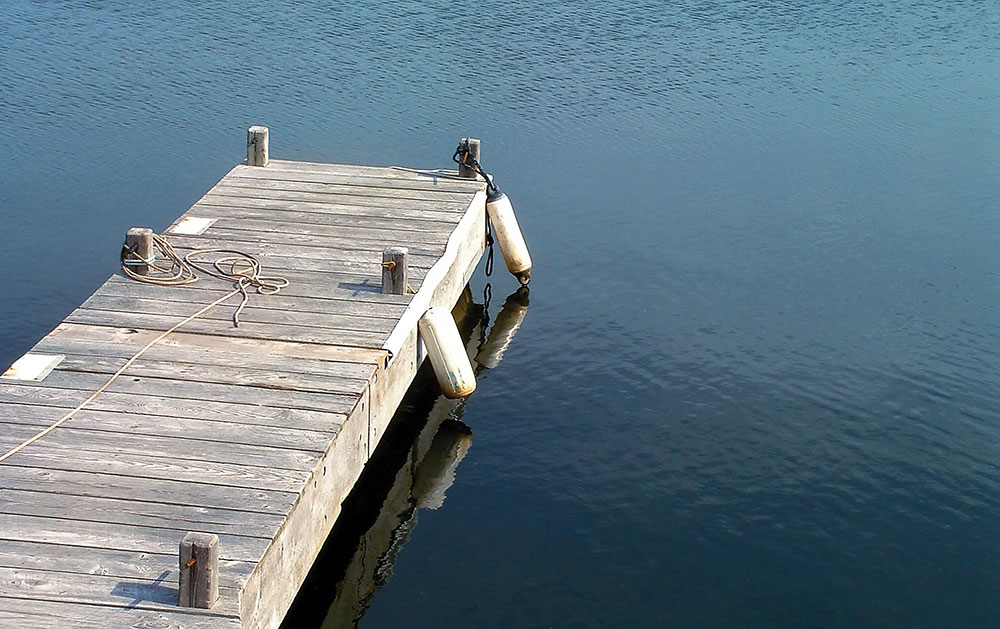
4. Warped Thinking Perfect the technique of “warping” to help you get out of tight docking situations.
Tips for Docking in the Wind
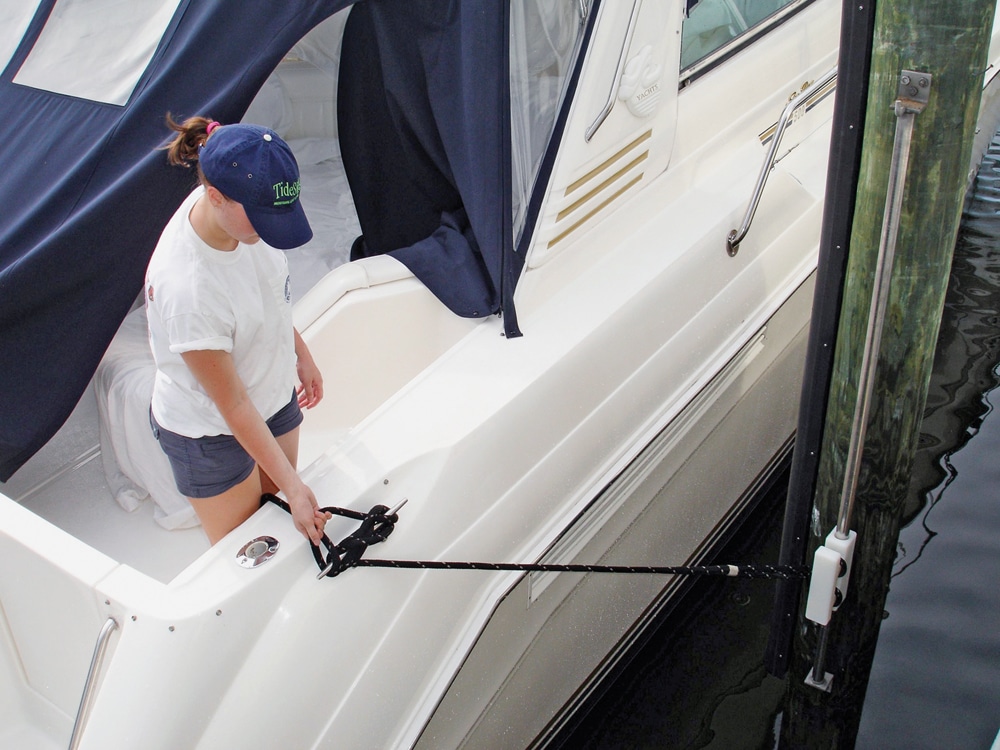
5. Leeward Lines First Remove the lines on the downward side first, since only the lines to weather are holding your boat in position.
Getting Out
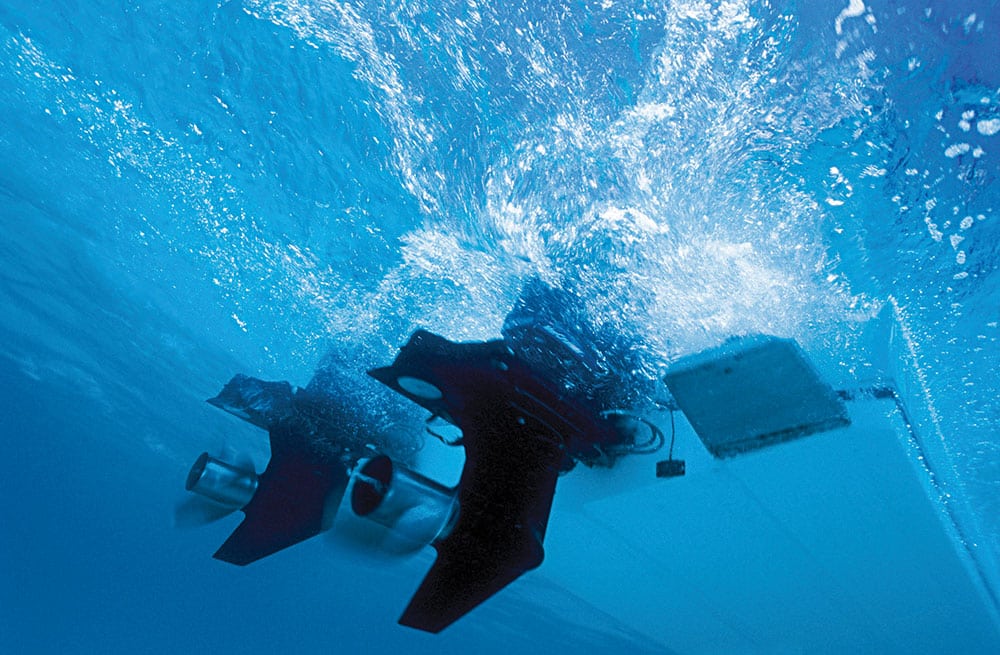
6. Using Reverse Learn how to make a reversing propeller your best friend and minimize stress and aggravation when docking.
Docking a Handicapped Twin-Screw
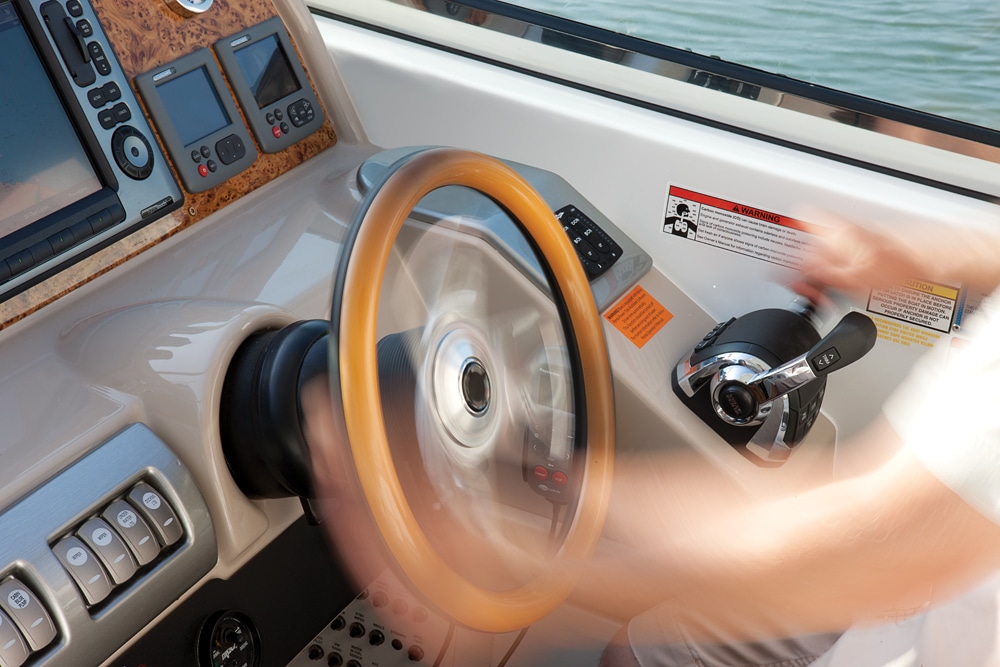
7. Watch Your Speed Minimal throttle, simply idling in gear, is the best speed for virtually every docking situation.
Dancing at the Dock
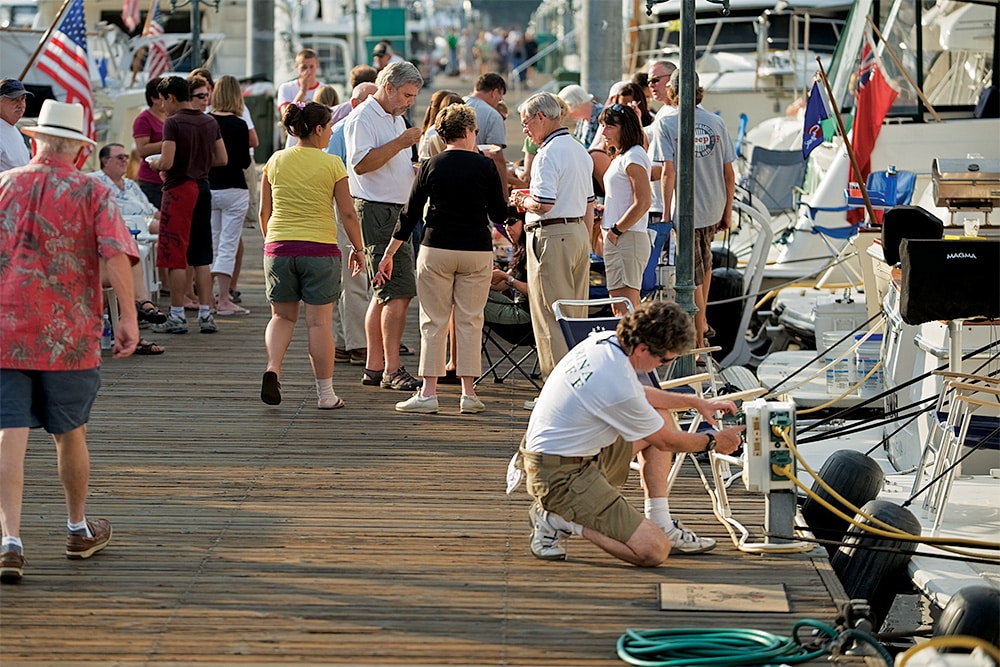
8. Stepping Up A dock hand will often step up onto a tied line, holding onto the boat for balance, and use the weight of her body to bring the boat in closer.
Doubling Up
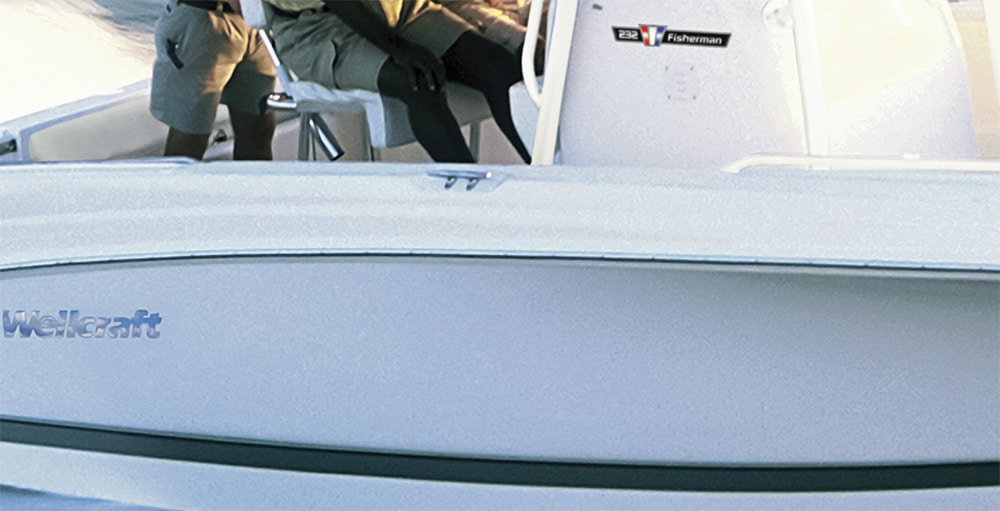
9. Controlled Docking The secret to “parallel parking” in a tight space is in knowing how to use the spring cleat properly.
Right Down the Middle
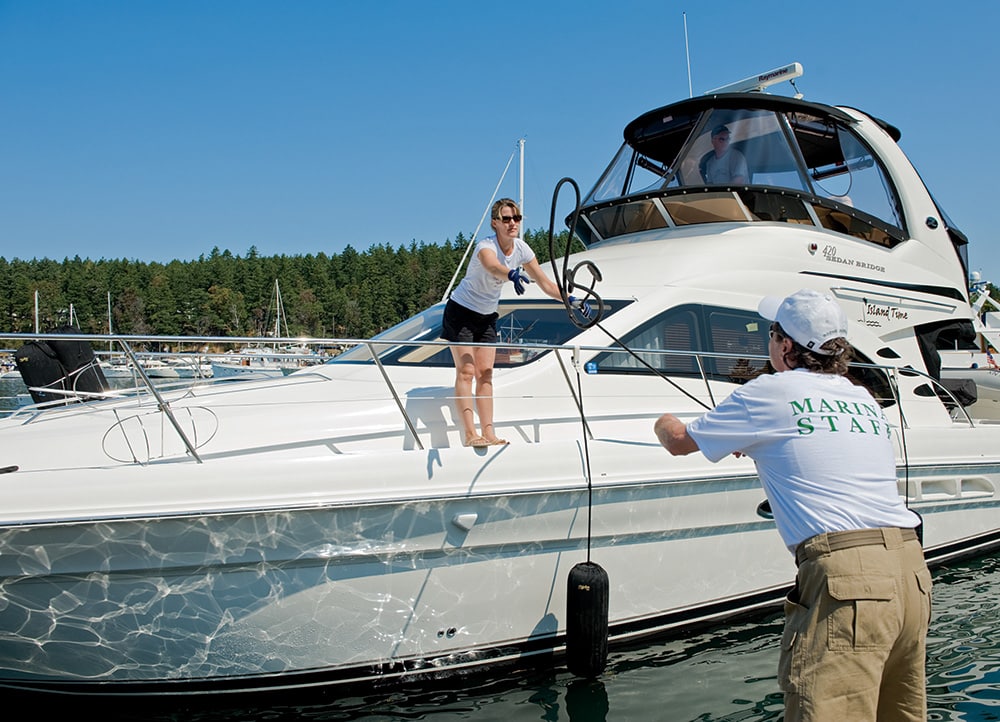
10. Toss a Line With a coil in each hand, step into a sidearm throwing motion, releasing when the coils are about shoulder high.
The Old Heave-Ho
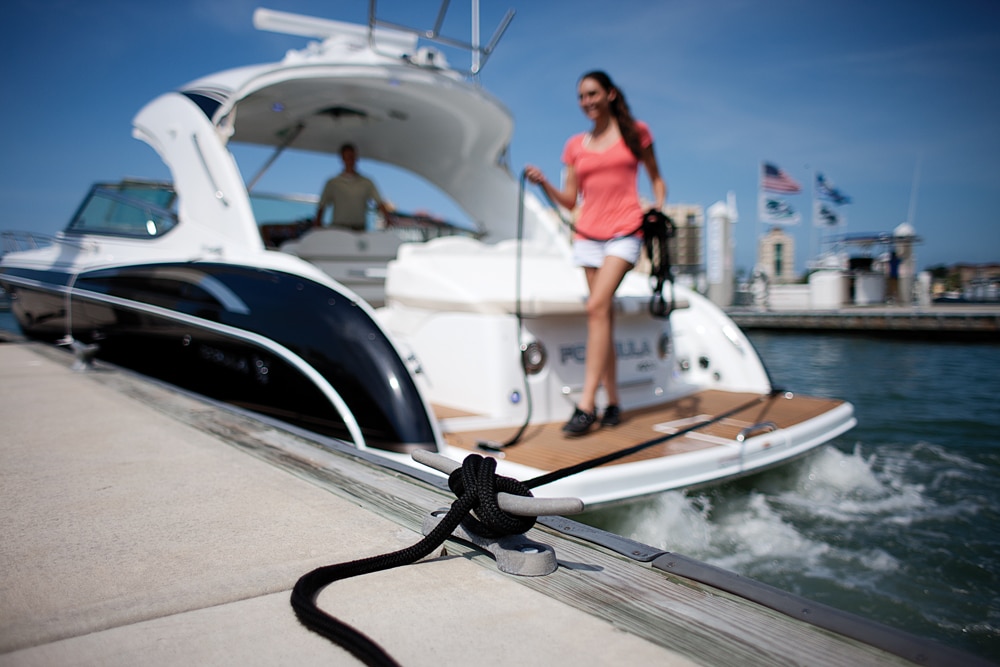
11. Hung Up Your boat can’t just be tied tight. You have to allow for the rise and fall of the water lest the boat be left hanging by its lines at low tide or pulled under by its lines at high tide.
Tips for Properly Rigging a Slip
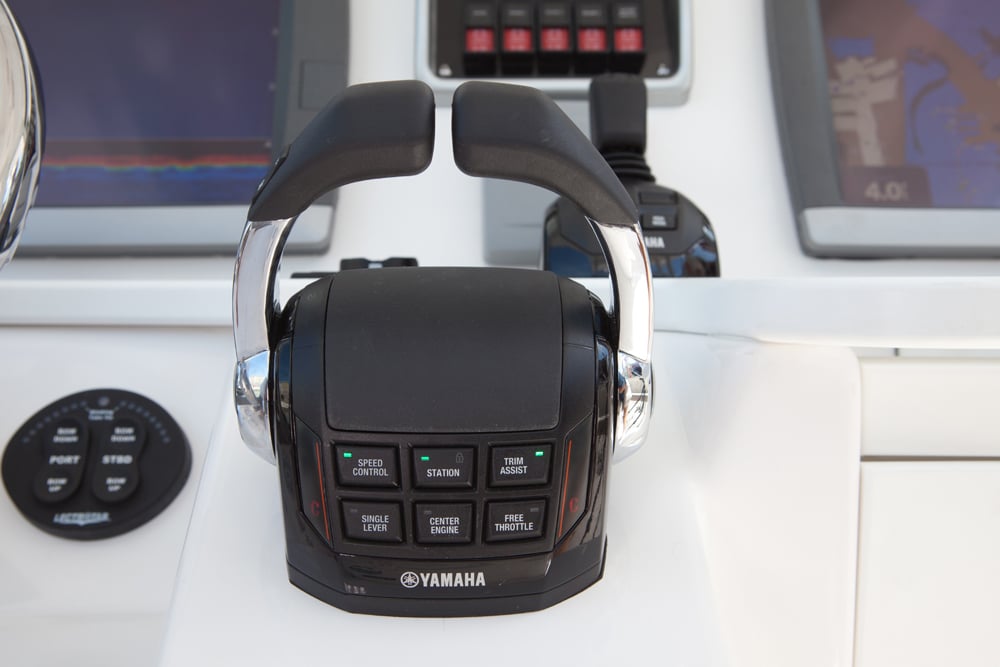
12. Make Small Steering and Throttle Corrections Use just enough throttle to move forward slowly, and if you need to shift to one side or the other, use small steering adjustments and wait for them to take effect before feeding in more.
Countercurrent
- More: docking , How-To , Photos
More How To
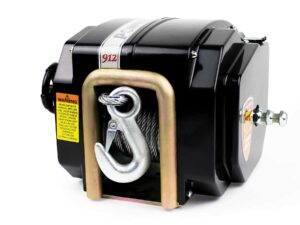
How to Choose a Trailer Winch
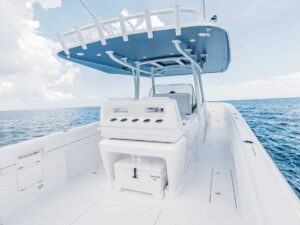
Best Non Skid Boat Deck Paint
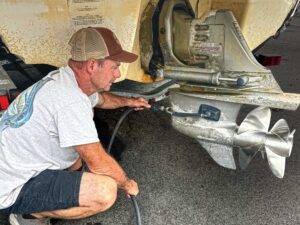
Midseason Sterndrive Maintenance
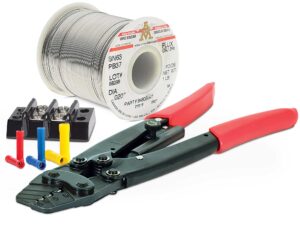
How to Properly Splice Wires on Your Boat
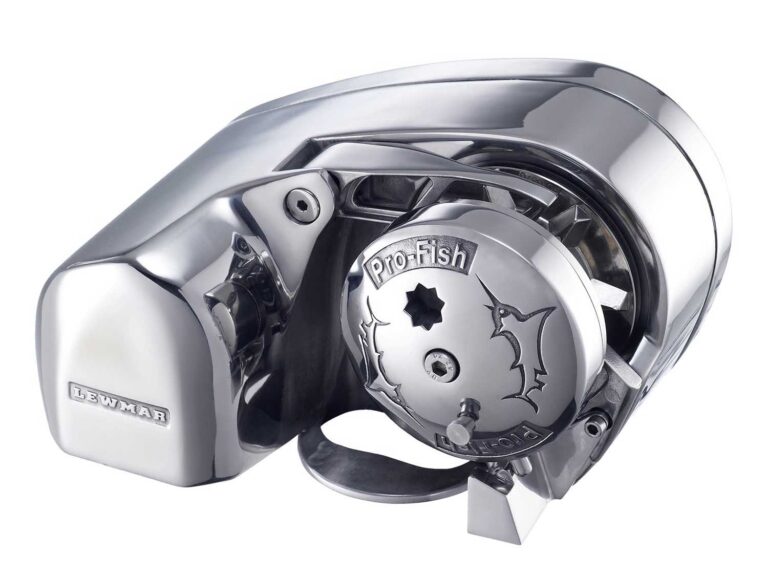
Ultimate Boat Anchor Winch Buyers’ Guide
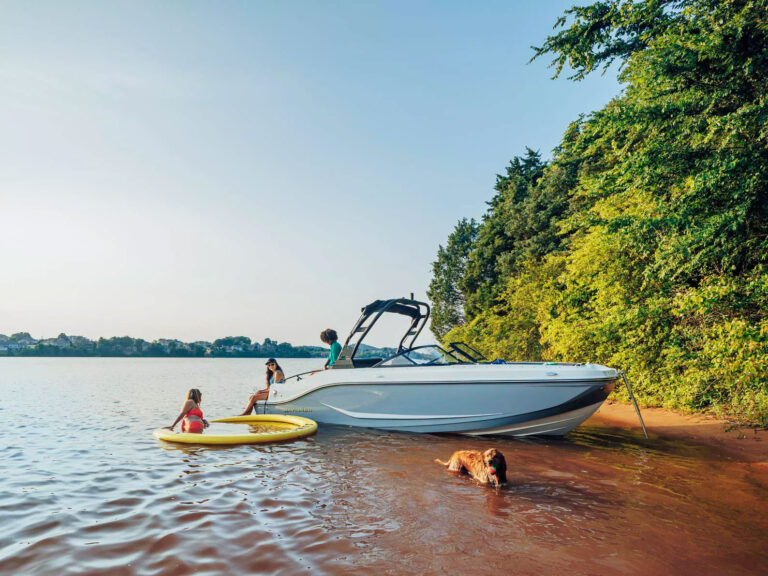
Bayliner 2024 D Series Deckboats Debut
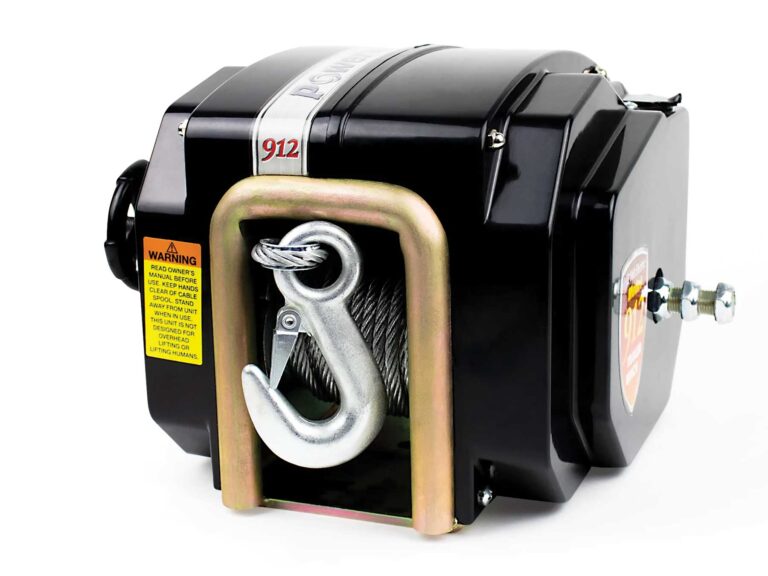
Is Your Trailer Right for Your Boat?

- Digital Edition
- Customer Service
- Privacy Policy
- Terms of Use
- Cruising World
- Sailing World
- Salt Water Sportsman
- Sport Fishing
- Wakeboarding
Many products featured on this site were editorially chosen. Boating may receive financial compensation for products purchased through this site.
Copyright © 2024 Boating Firecrown . All rights reserved. Reproduction in whole or in part without permission is prohibited.
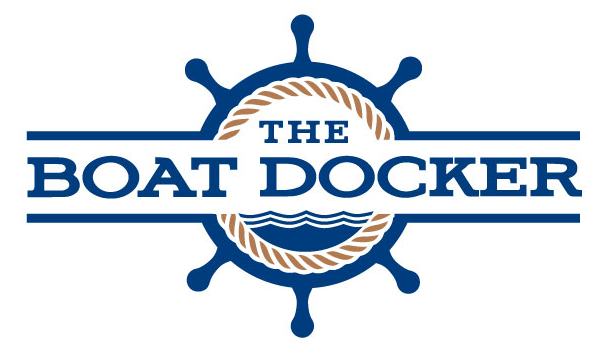
The Boat Docker
A Power Boat Docking Simulator
The Boat Docker Training
The following articles provide all of the information you need to know in order to operate The Boat Docker simulator.
Welcome to The Boat Docker
This simulator is designed to train you to dock your twin engine or single I/O power boat before you actually try it in the water! To get started, click above on “Run Simulator.” Thanks for all the feedback! We are continuously updating the simulator to make it a more effective tool. Please email your questions or […]
New Dock configuration
From: from Deniz Tok: Hello there. I just found out about your sim and I loved it! I can’t stop playing. I have a Searay 450 EB with twin engines and separated shifts & throttles. This sim makes great sense and really helps understanding the physics of the boat. Maybe only the wind physics differ […]
GamePad Bug Fix
Thanks to Roy Lewis for pointing out that the GamePad Controller software produces blank simulator screens in some devices. So, we have added a new menu item to either enable or not enable the GamePad Controller. The default setting is Not Enabled.
Added Gamepad support directly in browser
Hello Everyone, I once again added Gamepad support. This works for both wired and wireless Gamepads. Here is the mapping: B Button – Move Left Stern ThrusterA Button – Move Right Stern ThrusterY Button – Move Left Bow ThrusterX Button – Move Right Bow ThrusterL Button – Left Throttle UpR Button – Right Throttle UpZL […]
Using a Game Controller with Mac OS
From user Pete Harris: Love the simulator ! It’s great for developing muscle memory, so you can just focus on strategy when things get real. It was a bit daunting trying to figure out what game controller to buy, coupled with the worry I was wasting my time, and would not be able to get […]
Inbox Suggestion from user John Torkelson I am in the process of buying a 35 to 45 foot boat and need to make a decision on “do I need side thrusters or not?”. Your simulator is great for helping me make that decision and I thank you for your effort. I do have two suggestions for you. […]
Updated Wind / Water Indicators
We updated the Wind and Water Indicators to improve the user experience. Just click on the + / – symbols to increase / decrease the wind / water speed. Then click on any circle to change the wind / water direction.
We have upgraded our URL to include a new SSL certificate. The new URL is https://theboatdocker.com ! Thanks.
This configuration was proposed by John who asked for a modification to the Man Overboard that would “Simulate backing down on a fish.” The fish moves quite a bit faster than the Man Overboard, otherwise it operates the same. Click on the water to move the fish.
Rudder Effectiveness and Single I/O Prop Walk
Thanks to your suggestions we have added Rudder Effectiveness and Single I/O Prop Walk. You can now select low/medium/high rudder effectiveness from the start menu. Be sure to refresh your browsers on the menu page and then again on the simulator page. For a single I/O with an engine speed of 600 RPM, the engine […]

IMAGES
COMMENTS
Docking can be incredibly challenging and result in lots of damage to your boat, to other boats and to docks. Watch the video to see some simple tips to do t...
Learn how to dock a sailboat under sail, or under power, in a variety of different scenarios. Sailing legend Peter Isler walks us through the process using animations, illustrations and live action footage. Understand the techniques and skills required by both skipper and crew in order to make your docking experiences safe and easy.
Learn how to safely and correctly dock a sailboat with expert boating tips in this free video clip on sailing.Expert: Kelli Gant, Steve Damm, Ed PolkenhornBi...
Come see how to dock a sailboat CORRECTLY in this episode!Learn how to sail and how to dock a boat. Its easy to sail, Its also sometimes easy to sail out of ...
The series is written and narrated by two-time America's Cup winner Peter Isler who maps out the safe and correct methods of handling a sailboat both under sail or under power. Course Outline. The course consists of seven videos and can be completed in about 30-40 minutes. Sailors who purchase the course have 30-days of unlimited on-demand ...
DOCKING UNDER POWER. In this sailboat docking video, Offshore Sailing School Founder, Steve Colgate, shows you the best way to dock under power. This simple system gives you excellent control whether you are sailing with others or single-handed. Here are some helpful hints on how to dock a sailboat: Set up your aft amidships spring line first
Approach the dock at a steeper angle, so the wind pushes your boat towards the dock rather than away from it. Use your engine or sails to maintain a controlled speed and counteract the wind's force. Be prepared to make quick adjustments to your boat's position and speed as needed. 3. Docking and Undocking in Currents.
Follow our beginner's guide on how to dock a boat, 6 Steps to Docking a Boat Like a Pro, powered by Progressive®, to discover a few simple ways to feel more confident at the helm.Whether you are docking in a slip, coming alongside a dock, or docking against the wind or current, these pro tips will help you line up your approach and ensure you're ready for any docking scenario.
The Authority on How to Dock a Boat. "The recognized docking authority", Doug (5th generation boater) has published instructions for recreational boaters, for each drive system. Introductory and Advanced Lessons, with step-by-step instructions for docking a boat in hundreds of docking scenerios, are instantly accessible world-wide in ...
Ask Captain Chris about docking procedures for cruising boats with single engine, twin engine or pod drives both with and without thrusters. Learn easy to understand docking maneuvers with split screen views including controls at the helm and dockside landing. You will discover simple techniques to take the stress out of docking, keeping the pleasure in pleasure boating.
Prepare dock lines on your bow and stern and attach fenders. Line up your approach and survey the docking area. Judge the current, wind, and water conditions. Take your time, proceed slowly towards the dock using intermittent acceleration. Never approach a dock any faster than you're willing to hit it.
A big SeaRay docking in high winds at Tidewater Marina in VA. Watch the procedure and consider his decision to bow into the slip. Its was a good move understanding the conditions. #4 Docking Video - Single Engine Docking. Watch this new boat owner dock his single engine Mainship into the slip near White Rocks in the Chesapeake Bay.
BoatUS Magazine's Mike Vatalaro teaches you to how to bring your outboard- or sterndrive-powered boat alongside a dock or bulkhead in four simple steps. Lear...
Step 1: Line Up The Approach. Once you've decided on a place you would like to dock your boat, slowly begin to approach that spot at a 30 to 45-degree angle. If you feel that the wind and/or current is trying to keep you from getting to the dock, then slowly correct your approach by coming in at a shallow angle.
Make adjustments (reverse if you're going too fast, forward if you've lost way) and slow down until you are stopped or nearly stopped a few feet away from the dock. Ask the crew to toss the aft spring loop onto a cleat. Then pop into forward with very low throttle and turn the wheel away from the dock.
Tangle a mooring line in your propeller, and that docking job will go south in a hurry. #4: With twin inboards, don't touch the wheel. Ever. You'll be tempted, but you have more control if you leave the wheel centered and use only the engines. If you do turn the wheel, then when you try to use the engines and the prop-wash hits a cockeyed ...
To start, here are the most basic steps on how to dock a boat: Deploy fenders and prepare dock lines. Gauge the effects of wind and/or current. Drive up close to your slip or berth. Maneuver your boat so it's positioned to enter the berth or slip. Slow or stop forward momentum so you don't approach too fast.
12 Top Docking Tips. 12 Top Docking Tips Boating Magazine. 12. Make Small Steering and Throttle Corrections. Use just enough throttle to move forward slowly, and if you need to shift to one side or the other, use small steering adjustments and wait for them to take effect before feeding in more. Countercurrent.
November 22, 2022December 3, 2023 by boatdocker. This simulator is designed to train you to dock your twin engine or single I/O power boat before you actually try it in the water! To get started, click above on "Run Simulator.". Thanks for all the feedback! We are continuously updating the simulator to make it a more effective tool.
Follow our beginner's guide on how to dock a boat, 6 Steps to Docking a Boat Like a Pro, powered by Progressive®, to discover a few simple ways to feel more ...
Don't get distracted. 7. Attach your boat correctly. 8. Always wear your killswitch. 9. Only help others if you know what you're doing. 10. Don't be lazy (okay this is a jet ski fail, but ...
Keehi Small Boat Harbor loading dock repairs have been completed. The launch ramp and loading dock have been reopened, effective August 15, 2024. Department of Land & Natural Resources Division of Boating & Ocean Recreation 4 Sand Island Access Road Honolulu, Hawaii 96819. Tel: (808) 587-1966
Learn More About Your Boats Systems By Joining The Born Again Boating Academy! https://www.bornagainboating.com/Get Your Born Again Boating Clothing! https:/...
Captain Eric Sorensen shows you how to dock your single outboard boat in a slip. A critical boat-handling skill, docking a single outboard boat makes a lot o...
Want to help with the builds?? Follow the links below!Become a Patreon herehttps://www.patreon.com/user?u=22862832Buy merch herehttps://deadbeatgarage.myshop...
Lyrical Lemonade Presents:Lil Yachty & Veeze - SorryNotSorry (Official Music Video)Directed by AMD & Little MilesSong Produced by K4 & 183ZmanExecutive Produ...
ボートレース徳山 #ボートレースライブボートレース徳山 視聴者参加型ライブ配信「PLAY! BOAT! すなっち〜ずスタジアム」1~12Rライブ配信!8:12分 ...